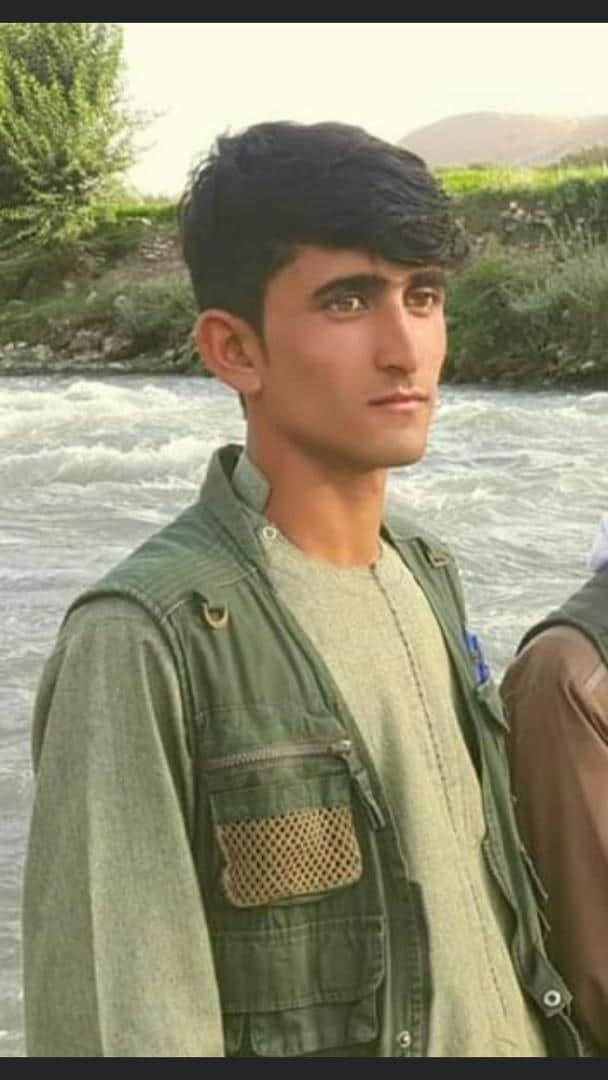Afghan youth Hekmatullah Sharifi, a 19-year-old boy from Balucha Village – Badakhshan province of Afghanistan was tragically shot and killed by the Iranian patrol police at the Afghan-Iran border. Hekmat was occupied by 14 other young boys that feared recruitment of the Taliban, therefore, fled to Iran for protection from the oppression. However, with attacks intensifying in several districts and cities across Afghanistan, and territorial gains from the Taliban including Badakhshan province, Iranian patrol police became apprehensive of Hekmat’s identity as an illegal immigrant and chose to favor in fatal action due to unwanted passing across the border into Iran.
Despite Hekmat’s efforts to escape through days of smuggling via vehicles and on foot into Iran like thousands of other Afghans, his life was taken without a second thought as the relations between Iran and Afghanistan is deemed poor.

Hekmatullah Sharifi, a 19-year-old boy from Balucha Village – Badakhshan poses for a picture by the river next to his house in 2021. picture sent to Rise to Peace by his friends.
It is evident that the Taliban are frightening Afghan and Iran neighborhoods, but more critically, the Iranian police appear the most alarmed and uneased from the threat. With the Taliban’s rule of targeting families with three or more young boys to fight for the Islamist organization, Afghan teens are fleeing their hometowns to seek a safe haven in Iran but also work and provide for their families instead of the Taliban. This is causing difficulties for the Iranian police, especially at their borders whilst tensions are high and trust in people is low.
Officers are seemingly terrified and overwhelmed by the fluid situation in Afghan that is provoked by the Deobandi Islamist movement and military organization (Taliban), and as a result of this, young individuals are being brutally killed at the scene instead of formally detained. Evidence confirms that Hekmat died at 5:00 AM on 5/8/1400 after surgery in response to the attack at a 200-bed hospital in Nimroz province.
Taliban Recruitment of Children
In the current day as the Taliban’s attempt to take-over of Central Asia, the Taliban are described to be seeking out families who have 3 or more young boys and state that whilst located in Afghanistan, one of the boys has a responsibility to go fight with the Taliban organization. Necessarily forced recruitment through invasions of homes and detriment of livelihoods, to which researchers have only concluded as a possibility of the Taliban’s recruitment over the years.
Reports have described the Taliban to be recruiting minors since the withdrawal of American troops from Afghanistan in early July, where they are described as child soldiers, human shields, and suicide bombers. It is blatant that Afghan communities are suffering since the American withdrawal. It has caused and will most likely continue to cause devastating outcomes for ethnic minorities similar to Hekmatullah for months to come. Young boys are aware of their fate set out with the Taliban and choose to risk their lives by fleeing than representing the Taliban and their version of Islam and creating peace.
Without the protection from foreign force troops on the ground, who are due to decrease drastically more until September 11th, 2021, there will always be a struggle to maintain livelihoods and critical facilitates in Central Asia.
How Can Afghanistan-Iran Authorities Do Better?
It is obvious that the governments of Afghanistan and Iran need to recognize a strategy to engage with the Taliban to discourage bloodshed, however, whilst this seems almost impossible in the current day, internal parties (i.e. patrol police) should prepare a better understanding of the hardened situations that differ in each region and allow an effective approach to questioning individuals that attempt to cross their borders. This has been the method for the Iranian patrol police towards Afghanistan people for decades when coming across desperate illegal immigrants.
Civilized and safe detainment of said individuals with a respect to human rights needs to be reinforced to better their relationship. Only then can innocent lives and low levels of youth militarization by the Taliban be preserved.
Chantelle Davis, Research Fellow at Rise to Peace
Homa Aryan M, Research Fellow at Rise to Peace





